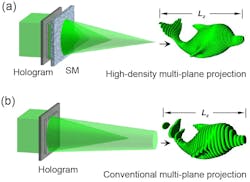Researchers exploit disordered scattering to improve depth control for holograms
A 3D hologram can present a real 3D scene’s continuous and fine features, but two long-standing problems with currently available digital holographic techniques—low axial resolution and high interplane crosstalk—prevent fine depth control of holograms and limit the quality of 3D displays of objects.
Researchers in China and Singapore recently teamed up to shape arbitrary light fields and came up with a novel way to break the depth-control limit to create dynamic ultrahigh-density 3D holographic projections (see Fig. 1 and video). Ultrahigh-density holograms are desirable for virtual-reality (VR) applications, in particular, because they pack in more depth information—and it results in more realistic-looking 3D displays of objects.
Light scattering “is usually perceived as a destructive effect in holography, but our work shows disordered scattering can be exploited to break the limitations in holographic projections,” says Lei Gong, a professor of optics at the University of Science and Technology of China, whose group worked on the project with Professor Chengwei Qiu’s group at the National University of Singapore. “It’s why we call our method ‘3D scattering-assisted dynamic holography.’”
Spatial light modulators (SLMs) are commonly used for dynamic holographic projection, but a serious drawback is that very few images can be projected onto separable planes and they’re at a low depth resolution.
The team outmaneuvered this with their three-dimensional scattering-assisted dynamic holography (3D-SDH) method, which combines a SLM with a diffuser. “It enables multiple images to be separated by a much smaller depth of focus (DoF)—without being limited by SLM pixel pitch or pixel number,” explains Gong. “Interplane crosstalk is suppressed by introducing random phase and orthogonality of random fields, so our method simultaneously reduces the DoF of image planes and suppresses interplane crosstalk to power up ultrahigh-density 3D holographic projection.”
Path to realistic 3D holograms
The team’s work is “a new paradigm toward realistic 3D holograms that can deliver exceptional representation of the 3D world around us,” says Gong. “We leverage disordered scattering by a diffuser for ultrafine 3D light field projection—and our approach breaks the depth-control limit of current state-of-the-art methods in multiplane holographic projection.”
When they put 3D-SDH to the test via simulations, the researchers found it produced 3D reconstructions with a much smaller depth interval between each plane (see Fig. 2). As part of this test, a 3D rocket model—with 125 successive images planes at a depth interval of 0.96 mm within a single 1000 × 1000 pixel hologram—was projected. This is a big improvement compared to random vector-based computer-generated holography, which can achieve only 32 image planes with a depth interval of 3.75 mm.The team also experimentally validated the concept by building a prototype 3D-SDH projector so they could create dynamic 3D projections to compare to a conventional setup for 3D Fresnel computer-generated holography.
Compared to projection with a SLM, 3D-SDH provides an improvement in depth resolution by more than three orders of magnitude. It also enables dynamic 3D vectorial projections with phase-only holograms.
3D-SDH may find use in applications such as VR, 3D printing, and holographic-based optical encryption. VR creates an illusion of 3D viewing commonly via headsets, while holograms can provide better naked-eye 3D visualization. For a holographic VR headset, 3D-SDH can help greatly improve the viewing angle of the holographic display—which enhances the 3D-viewing experience. And holographic-based optical encryption can benefit from more data being encrypted inside a hologram.
“Our current 3D holograms reconstructed only point-cloud 3D images (which can’t present the solid body of a 3D object), but they can be viewed from any direction over the full 4π solid angle,” says Gong. “Our ultimate goal is to project a solid body of 3D objects with a hologram. The complexity of reconstructed 3D images is still limited due to the finite modes of the hologram, and a much higher pixel-count hologram is required to project complicated 3D scenes.”
Generating such a 3D hologram is a challenge, and the researchers say new algorithms will be necessary to pull it off. Beyond this, they say a judicially designed scattering medium will also be needed—instead of measuring the large 3D transmission matrix of the medium.
“We’re thrilled that light scattering from a scattering medium can bring new perspectives for improving depth control for holograms,” Gong adds.
FURTHER READING
P. Yu et al., Optica, 10, 4 (2023); doi:10.1364/optica.483057.
About the Author
Sally Cole Johnson
Editor in Chief
Sally Cole Johnson, Laser Focus World’s editor in chief, is a science and technology journalist who specializes in physics and semiconductors.



